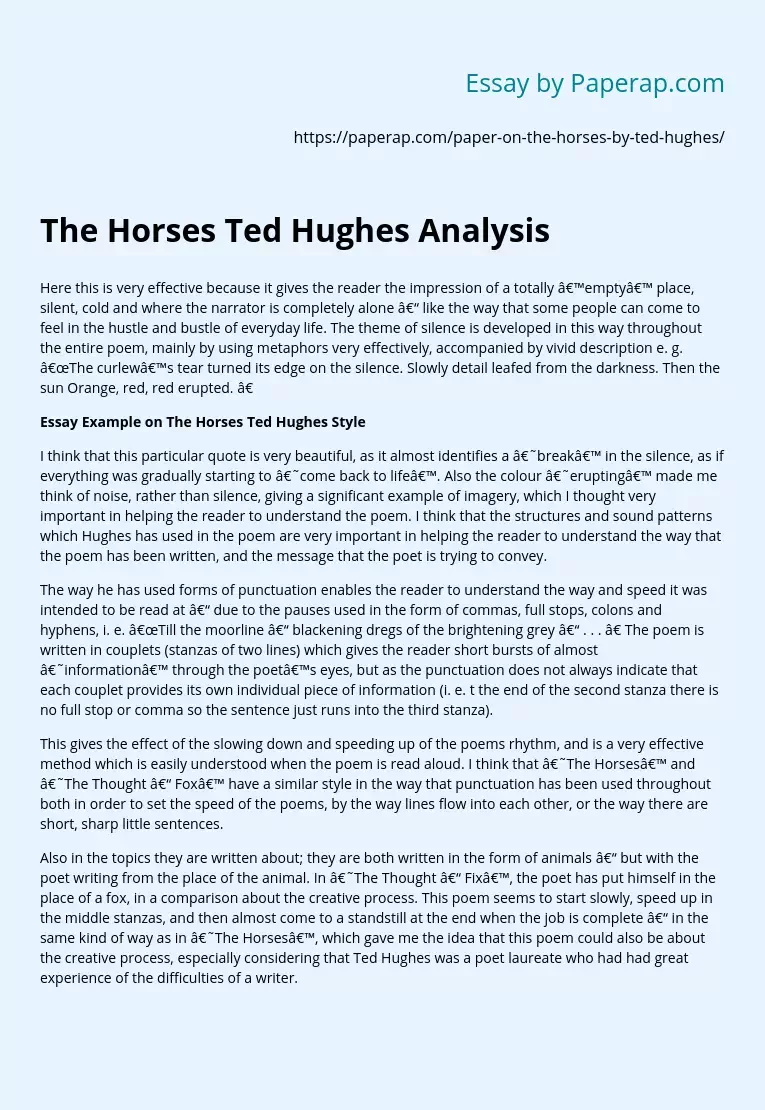Here this is very effective because it gives the reader the impression of a totally ’empty’ place, silent, cold and where the narrator is completely alone – like the way that some people can come to feel in the hustle and bustle of everyday life. The theme of silence is developed in this way throughout the entire poem, mainly by using metaphors very effectively, accompanied by vivid description e. g. “The curlew’s tear turned its edge on the silence. Slowly detail leafed from the darkness.
Then the sun Orange, red, red erupted. ”
Essay Example on The Horses Ted Hughes Style
I think that this particular quote is very beautiful, as it almost identifies a ‘break’ in the silence, as if everything was gradually starting to ‘come back to life’. Also the colour ‘erupting’ made me think of noise, rather than silence, giving a significant example of imagery, which I thought very important in helping the reader to understand the poem. I think that the structures and sound patterns which Hughes has used in the poem are very important in helping the reader to understand the way that the poem has been written, and the message that the poet is trying to convey.
The way he has used forms of punctuation enables the reader to understand the way and speed it was intended to be read at – due to the pauses used in the form of commas, full stops, colons and hyphens, i. e. “Till the moorline – blackening dregs of the brightening grey – .
. . ” The poem is written in couplets (stanzas of two lines) which gives the reader short bursts of almost ‘information’ through the poet’s eyes, but as the punctuation does not always indicate that each couplet provides its own individual piece of information (i. e. t the end of the second stanza there is no full stop or comma so the sentence just runs into the third stanza).
This gives the effect of the slowing down and speeding up of the poems rhythm, and is a very effective method which is easily understood when the poem is read aloud. I think that ‘The Horses’ and ‘The Thought – Fox’ have a similar style in the way that punctuation has been used throughout both in order to set the speed of the poems, by the way lines flow into each other, or the way there are short, sharp little sentences.
Also in the topics they are written about; they are both written in the form of animals – but with the poet writing from the place of the animal. In ‘The Thought – Fix’, the poet has put himself in the place of a fox, in a comparison about the creative process. This poem seems to start slowly, speed up in the middle stanzas, and then almost come to a standstill at the end when the job is complete – in the same kind of way as in ‘The Horses’, which gave me the idea that this poem could also be about the creative process, especially considering that Ted Hughes was a poet laureate who had had great experience of the difficulties of a writer.
On the other hand these two poems have many differences. They are set out differently; ‘The Horses’ is written in couplets whereas ‘The Thought – Fox’ is set out in six stanzas of four lines each. Also there is more evident use of punctuation to change the rhythm in ‘The Horses’, whereas in ‘The Thought – Fox’ there is hardly any punctuation, making it quite a fast – paced poem, all flowing into one.
The Horses Ted Hughes Analysis. (2019, Nov 27). Retrieved from https://paperap.com/paper-on-the-horses-by-ted-hughes/

